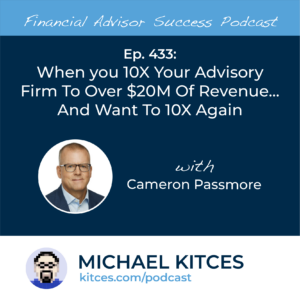 Welcome everyone! Welcome to the 433rd episode of the Financial Advisor Success Podcast!
Welcome everyone! Welcome to the 433rd episode of the Financial Advisor Success Podcast!
My guest on today's podcast is Cameron Passmore. Cameron is the CEO of PWL Capital, a wealth management firm based in Ottawa, Canada, that oversees just over $5 billion Canadian dollars (or approximately $3.5B U.S. dollars) in assets under management for 2,400 client households.
What's unique about Cameron, though, is how, after 10X'ing the firm's revenue (from $2 million to more than $20 million) over the course of the past decade as an independent, his firm decided that combining with a larger financial conglomerate would provide the best opportunity for the business to achieve its next round of 10X growth in the decade to come.
In this episode, we talk in-depth about how Cameron's firm experienced significant client and revenue growth by serving the CEO and employees of e-commerce platform Shopify early on in its growth path (eventually leading to massive AUM growth after the company's IPO), how Cameron's firm managed to generate over 1,100 inbound leads resulting in more than 200 new clients in just the past year driven primarily by its thought leadership content (including the Rational Reminder podcast, a YouTube channel, and white papers), and how Cameron's planning focus and passive investing approach has helped his firm stand out amongst the bank- and brokerage-dominated Canadian financial advice market.
We also talk about how Cameron's firm (after achieving its 10X revenue growth) conducted an exercise to envision ways to achieve its next round of 10X growth to be what he calls a “company of consequence” that could help change the landscape for financial advice in Canada, why Cameron turned down acquisition interest from firms that were primarily focused on the financial incentives of M&A but ultimately took a deal that was more focused on the opportunity to grow the impact of his business, and how Cameron's firm ultimately decided to sell to the U.S.-based business and financial services conglomerate OneDigital to provide the financial backing and corporate connections to support PWL Capital in its next growth phase (including through acquisitions of its own with other like-minded firms in Canada).
And be certain to listen to the end, where Cameron shares why his firm invested heavily into internal data management (including investing in an institutional quality “data lake”) not to reduce its technology costs, but rather to create tools that reflect the firm's planning approach and the client experience it wants to create, how Cameron's firm leverages planning teams consisting of a lead advisor, financial planning associate, and operations specialist (with Cameron and other firm leaders available to assist when necessary) that can serve 175 client households and generate approximately $1 to $1.5 million U.S. dollars in revenue, and how Cameron's willingness to just meet and get to know other advisors, businesses, and content creators, without having a specific goal in mind, has led to multiple serendipitous business opportunities throughout his career.
So, whether you're interested in learning about engaging on a new growth path after already achieving significant growth as a firm, investing in internal data management capabilities, or the process of evaluating acquisition offers, then we hope you enjoy this episode of the Financial Advisor Success podcast, with Cameron Passmore.




